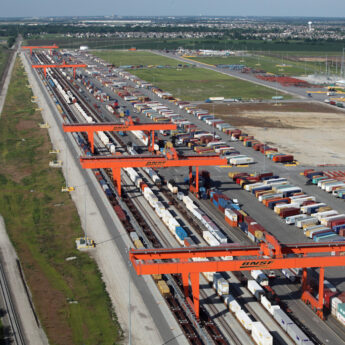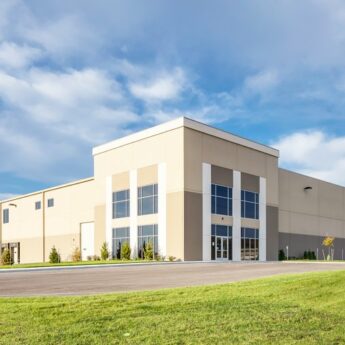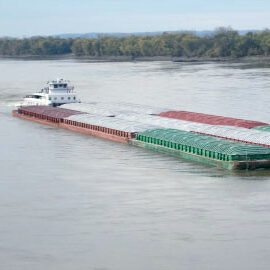HOME | ABOUT US | MEDIA KIT | CONTACT US | INQUIRE
HOME | ABOUT US | MEDIA KIT | CONTACT US | INQUIRE
PUBLISHED NOVEMBER 2023
Kansas City is home to some massive logistics facilities, highlighted by Logistics Park Kansas City, with more than 17 million square feet of warehouse and distribution space in the southwest quarter of Johnson County on the Kansas side. At Kansas City International Airport, the Intermodal Business Centre is emerging as a nearly 700-acre master-planned development, and nearby, Hunt Midwest has amassed 3,300 acres for development of the region’s biggest logistics centers. On the region’s southern fringe, Port KC manages nearly 490,000 square feet of space available at Richards-Gebaur Commerce Park, part of the larger 49 Crossing innovation/logistics initiative. And other industrial parks are popping up near Gardner in Johnson County and, on the Missouri side, in Liberty in Clay County. All told, those assets and many others have elevated Kansas City’s profile on the national logistics stage.
 Highways: It’s been a point of pride in this region for years: The Kansas City region has more freeway lane miles per capita than any American city of more than 1 million in population, and it’s not even close: Our 6.7 miles of roadway per 1,000 residents is well ahead of the 5.9 miles per 1,000 in the No. 2 cities of Pittsburgh and Atlanta. As a result, traffic flows more freely here than anywhere else: Among cities with at least 2,000 freeway lane miles, we average 26.2 vehicles per mile, well ahead of No. 2 Pittsburgh at 28.8. Federal transportation officials also say Kansas City ranks No. 3 nationally in trucking volume.
Highways: It’s been a point of pride in this region for years: The Kansas City region has more freeway lane miles per capita than any American city of more than 1 million in population, and it’s not even close: Our 6.7 miles of roadway per 1,000 residents is well ahead of the 5.9 miles per 1,000 in the No. 2 cities of Pittsburgh and Atlanta. As a result, traffic flows more freely here than anywhere else: Among cities with at least 2,000 freeway lane miles, we average 26.2 vehicles per mile, well ahead of No. 2 Pittsburgh at 28.8. Federal transportation officials also say Kansas City ranks No. 3 nationally in trucking volume.
 Rail: The U.S. now has six Class I railroads, following last year’s merger of Kansas City Southern Railway and Canadian Pacific. The new CPKC is joined by BNSF Railway, Norfolk Southern, CSX, and Union Pacific on the roster of railroads serving this region. Only Canadian National has a line running here. Because of those connections, Kansas City ranks No. 1 nationally in rail tonnage and No. 2 in rail traffic. BNSF, in particular, has a huge presence with its intermodal facility adjacent to Logistics Park Kansas City near Gardner.
Rail: The U.S. now has six Class I railroads, following last year’s merger of Kansas City Southern Railway and Canadian Pacific. The new CPKC is joined by BNSF Railway, Norfolk Southern, CSX, and Union Pacific on the roster of railroads serving this region. Only Canadian National has a line running here. Because of those connections, Kansas City ranks No. 1 nationally in rail tonnage and No. 2 in rail traffic. BNSF, in particular, has a huge presence with its intermodal facility adjacent to Logistics Park Kansas City near Gardner.
 Industrial Real Estate: Activity has slowed a bit year over year, but according to JLL, industrial growth so far this year would be at a historic high compared to any year other than 2022. Net absorption through the third quarter was 7.01 million square feet, 3.58 million square feet were under construction, and 9.31 million square feet came onto the market in 2023. JLL projects the vacancy rate will continue to trend down, limiting the options for tenants evaluating their space needs. While huge warehouses have seen explosive construction growth, most of the leasing is in the range of 50,000 to 200,000 square feet.
Industrial Real Estate: Activity has slowed a bit year over year, but according to JLL, industrial growth so far this year would be at a historic high compared to any year other than 2022. Net absorption through the third quarter was 7.01 million square feet, 3.58 million square feet were under construction, and 9.31 million square feet came onto the market in 2023. JLL projects the vacancy rate will continue to trend down, limiting the options for tenants evaluating their space needs. While huge warehouses have seen explosive construction growth, most of the leasing is in the range of 50,000 to 200,000 square feet.

Aviation: More than 128,000 tons of air cargo passed through Kansas City International Airport in 2022, and while that was down year-over-year, the decline came in the wake of a 25 percent increase just since 2018. That annual figure is likely to swell even further with Hunt Midwest acquisition of 3,300 acres adjacent to the airport, where its KCI 29 Logistics Park will build out at 18 million square feet of Class A logistics and manufacturing space.
 Waterways: Yep, even ocean-bound cargo can originate from this region, with the Missouri River bisecting the state from Kansas City to St. Louis. It starts upriver from Kansas City with port operations in St. Joseph, then continues for 450 meandering miles to the Mississippi River at St. Louis. From there, it’s about 1,000 miles downstream to the Gulf of Mexico. While primarily an intrastate route for shipping construction materials like stone, sand, and gravel, the river traffic is able to accommodate farm and food products, manufactured goods, chemicals, and fertilizer.
Waterways: Yep, even ocean-bound cargo can originate from this region, with the Missouri River bisecting the state from Kansas City to St. Louis. It starts upriver from Kansas City with port operations in St. Joseph, then continues for 450 meandering miles to the Mississippi River at St. Louis. From there, it’s about 1,000 miles downstream to the Gulf of Mexico. While primarily an intrastate route for shipping construction materials like stone, sand, and gravel, the river traffic is able to accommodate farm and food products, manufactured goods, chemicals, and fertilizer.